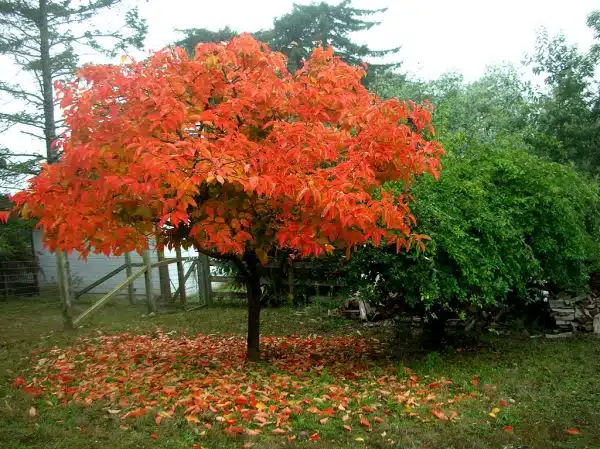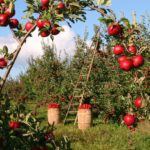When it comes to growing fruit trees, persimmon trees are a popular choice for many gardeners and farmers. The sweet and tangy taste of persimmons makes them a delicious addition to any dish or as a stand-alone snack. However, growing persimmon trees requires specific knowledge and care in order to produce a healthy and bountiful harvest.
In this article, we will explore the necessary steps to grow persimmon trees successfully. From selecting the right site for planting to providing proper care throughout the year, we will cover all aspects of persimmon tree cultivation. Whether you’re a seasoned gardener or just starting out, our guide will provide valuable information that will help you grow thriving persimmon trees that yield an abundant crop for years to come.
Understanding Persimmon Tree Varieties
The persimmon tree, also known as Diospyros kaki, is a beautiful fruit-bearing tree that can be found all over the world. With its unique and striking appearance, it’s no wonder why gardeners and enthusiasts alike are drawn to this plant.
There are two types of persimmon trees: astringent and non-astringent. The astringent variety is typically larger in size and has a more bitter taste when not ripe. The non-astringent variety is smaller in size and has a sweeter taste even when not fully ripened. Within these two types, there are many cultivars to choose from that have varying characteristics such as the shape of the fruit or the color of the leaves.
When choosing which type or cultivar of persimmon tree to grow, it’s important to consider your climate zone and soil conditions. Some varieties thrive in warmer climates while others prefer cooler temperatures. Additionally, some cultivars do better in well-draining soils while others require moist soil conditions. By taking into account these factors, you can ensure that you select the best variety for your specific location.
Transitioning into the next section about choosing the right site for planting, it’s crucial to keep in mind that selecting the appropriate type and cultivar of persimmon tree is only part of ensuring successful growth. The next step is finding the perfect spot for planting your sapling.
Choosing The Right Site For Planting
Understanding the different varieties of persimmon trees is essential to ensure a successful planting and growth process. However, choosing the right site for planting is equally important. Soil composition and drainage requirements are two critical factors to consider when selecting a location for your persimmon tree.
Persimmon trees require well-draining soil with a pH level between 6.0 and 7.5. The ideal soil type for persimmon trees is loamy soil, which contains an equal proportion of sand, silt, and clay. Avoid planting in heavy clay soils or soil that retains too much water as they can cause root rot and other diseases. Additionally, it is crucial to ensure that the location you choose has adequate drainage to prevent waterlogging.
Once you have selected the right site for your persimmon tree, it’s time to prepare the soil and plant it correctly. Soil preparation involves clearing the area of weeds and debris before tilling or digging up the soil to a depth of about 18 inches. You can then add compost or well-rotted manure to improve soil fertility and structure. When planting, dig a hole that is slightly larger than the root ball of your tree, backfill with enriched topsoil, tamp down gently around the base of the trunk, water thoroughly, and add mulch around the base.
When choosing a site for planting persimmon trees, it’s essential to consider aspects such as soil composition and drainage requirements carefully. Persimmons thrive in well-draining loamy soils with a pH between 6.0-7.5; thus heavy clay soils should be avoided as they can cause root rot problems in persimmons. After selecting an appropriate site for your tree, proper soil preparation techniques should be employed when planting your tree to ensure optimal growth conditions are met from day one!
Soil Preparation And Planting Techniques
When growing persimmon trees, it is important to choose the right soil. A well-draining, loamy soil with a pH between 6.5 and 7.5 is ideal. Preparing the soil is also important; it should be enriched with organic matter like compost or aged manure and tilled to a depth of at least 12 inches. Planting persimmon trees can be done in early spring or late fall. The hole should be twice as wide as the root ball and the same depth. The tree should be placed at the same depth as it was originally in its container. The roots should be spread out and the soil should be firmly packed around the tree. A layer of mulch should be added to help retain moisture.
Choosing The Right Soil
The success of a persimmon tree’s growth is heavily dependent on the soil it is planted in. Choosing the right soil is crucial to ensure optimal growth and fruit production. One important factor to consider when selecting soil for planting persimmon trees is the pH level. Persimmons thrive in slightly acidic soils with a pH range of 6.0 to 7.5. Soil testing kits are readily available and can be used to determine the pH level of your garden soil. If the soil pH is too high, adding sulfur or peat moss can help lower it.
Another critical aspect to consider when choosing soil for persimmon trees is drainage management. These trees require well-draining soils that do not retain water for too long as waterlogged soils can lead to root rot and other diseases. Adding organic matter such as compost or aged manure can improve soil structure, resulting in better drainage and aeration, which promotes healthy root development.
In summary, selecting suitable soil for persimmon trees requires consideration of two primary factors: pH level and drainage management. It’s crucial to plant persimmon trees in slightly acidic soils with good drainage properties, as these factors are essential for their optimal growth and fruit production. By ensuring these conditions are met, you will have a thriving persimmon tree that produces delicious fruit year after year!
Soil Preparation
Soil preparation is a crucial step in ensuring the success of planting persimmon trees. Proper soil preparation involves creating an ideal environment for the tree to grow and thrive. One essential aspect of soil preparation is composting techniques. Adding organic matter such as compost or aged manure can help improve soil structure, nutrient availability, and water retention capacity. Composting also helps increase the number of beneficial microorganisms in the soil, which aids in nutrient cycling and disease suppression.
Another vital factor to consider when preparing soil for persimmon trees is pH testing. Persimmons prefer slightly acidic soils with a pH range of 6.0 to 7.5. Soil testing kits are readily available and can be used to determine the pH level of your garden soil. If the pH level is too high, adding sulfur or peat moss can help lower it to achieve an optimal growing environment for persimmon trees.
In summary, proper soil preparation plays a crucial role in establishing healthy persimmon trees that produce abundant fruit year after year. Composting techniques and pH testing are two critical factors that should be considered when preparing the soil for planting persimmon trees. By following these guidelines, you can create an ideal growing environment that promotes optimal growth, health, and fruit production for your persimmon tree.
Planting Techniques
Now that we have discussed the importance of soil preparation, let us delve into another crucial aspect of planting persimmon trees – planting techniques. Proper planting techniques can significantly influence the growth, health, and fruit production of persimmon trees. One essential factor to consider when planting is the planting depth. To ensure that a persimmon tree thrives, it should be planted at the same depth as its root ball. Planting too deep or too shallow can negatively impact the tree’s growth and development.
Another critical aspect to consider is the size of the root ball. Persimmon trees have a shallow root system that needs proper support during transplanting. Therefore, it is essential to have an adequate-sized root ball when digging up a persimmon tree for transplanting. A good rule of thumb is to dig up a root ball that measures ten inches in diameter for every inch in trunk diameter.
Mulching and irrigation are also important factors to consider when planting persimmon trees. Mulching helps retain moisture in the soil and suppress weeds while providing nutrients as it decomposes over time. It would be best if you mulched around your newly planted persimmon tree but avoid piling mulch against its trunk as this can lead to rotting. Irrigating regularly is also essential for promoting healthy growth by keeping the soil moist without waterlogging it.
In conclusion, proper planting techniques play an integral role in ensuring the success of growing persimmon trees. Considerations such as planting depth and root ball size must be taken into account during transplanting, while mulching and irrigating are necessary post-planting steps for maintaining optimal growth conditions. With these guidelines in mind, you can establish healthy and fruitful persimmon trees that will provide bountiful harvests for years to come.
Sunlight And Watering Needs
On average, persimmon trees require moderate watering frequency. Depending on the weather conditions and soil type, they may need to be watered once or twice a week. However, it is essential to avoid overwatering as this can lead to root rot and other fungal diseases. It is best to water persimmon trees in the morning or evening when the sun is not too intense.
Persimmon trees are known for their shade tolerance, making them ideal for planting in areas with partial shade. While they prefer full sunlight, they can still thrive in shaded areas as long as they receive at least four hours of direct sunlight each day. If planted in an area with too much shade, these trees may produce less fruit and have weaker growth.
Proper watering frequency and adequate sunlight are essential for growing healthy persimmon trees. However, fertilization and pruning are also crucial steps that should not be overlooked. In the next section, we will discuss how to properly fertilize and prune your persimmon tree to ensure optimal growth and fruit production.
Fertilization And Pruning
Fertilization and pruning are two essential aspects of growing persimmon trees. Proper fertilization ensures that the tree receives all the necessary nutrients for healthy growth, while pruning techniques help to maintain its shape and promote fruit production. Here are some guidelines on how to fertilize and prune your persimmon tree.
Firstly, it is crucial to follow a fertilization schedule that suits the needs of your tree. Persimmon trees require nitrogen, phosphorus, and potassium in specific amounts during different stages of growth. A balanced fertilizer with equal proportions of these three elements is recommended during the first few years after planting. Once the tree reaches maturity, switch to a low-nitrogen fertilizer with higher levels of phosphorus and potassium to encourage fruiting.
Secondly, pruning is an important practice that helps to shape the persimmon tree into a desired form for better sunlight exposure and air circulation. Pruning should be done during dormancy in late winter or early spring before new growth appears. Remove any dead or diseased branches, as well as any weak or crossing branches that may cause damage or inhibit fruit production.
Lastly, avoid over-pruning your persimmon tree as this can lead to reduced fruiting capacity. Only remove what is necessary for maintaining the tree’s health and overall structure. Remember that each cut made on a branch affects its future growth pattern; make cuts at a 45-degree angle just above a bud facing outward from the center of the tree.
- Use a balanced fertilizer with equal proportions of nitrogen, phosphorus, and potassium during the first few years after planting.
- Switch to a low-nitrogen fertilizer with higher levels of phosphorus and potassium once the tree reaches maturity.
- Make cuts at a 45-degree angle just above a bud facing outward from the center of the tree when pruning.
Incorporating these fertilization and pruning techniques will ensure your persimmon tree grows healthy and produces an abundance of fruit. However, just like any other plant, persimmon trees are susceptible to pest and disease problems that can affect their growth and fruit production. Therefore, the next section will discuss effective ways to manage these issues and ensure a successful harvest.
Pest And Disease Management
- Proper pest control is paramount to successfully growing persimmon trees. There are a variety of methods available to control pests, including physical removal, use of insecticides, and introduction of beneficial insects.
- Disease prevention is an effective strategy to ensure healthy persimmon trees. This can be accomplished through soil management, use of disease-resistant varieties, and proper pruning techniques.
- It is also important to inspect persimmon trees regularly for signs of pest infestations or disease. Early detection can help to prevent further spread of pests or diseases.
- With the appropriate pest and disease management methods, it is possible to have a healthy, productive persimmon tree.
Pest Control
Pest control is an essential aspect of persimmon tree cultivation. As a horticulturist or arborist, it is crucial to understand the different pests that can affect persimmon trees and the best management practices to keep them at bay. Natural remedies are highly recommended as they pose no harm to the environment and are cost-effective. However, in severe cases, chemical pesticides may be necessary.
One of the most common pests that affect persimmon trees is the Asian Persimmon Fruit Fly. This pest lays eggs on ripe fruit, leading to premature rotting and damage. To manage this pest naturally, one can use sticky traps or bagging techniques that prevent the flies from accessing the fruit. Additionally, one can prune any infected branches or fruits immediately to reduce further spreading of the pest. If using chemical pesticides, it is important to follow manufacturer’s instructions carefully and apply them when there are no pollinators around.
Another pest that affects persimmon trees is aphids, which suck sap from leaves leading to yellowing and stunted growth. Natural remedies such as spraying with soapy water or using ladybugs as predators can be effective in managing this pest. In some cases where infestation is high or persistent, a targeted application of chemical insecticides may be necessary.
In conclusion, natural remedies should always be considered first when dealing with pests affecting persimmon trees due to their effectiveness and environmental friendliness. However, in severe cases where natural remedies have failed, targeted applications of chemical pesticides may be necessary for effective management. As a horticulturist or arborist serving others who desire healthy and productive persimmon trees, it is important to stay informed on best management practices for pest control.
Disease Prevention
Preventing disease is an integral part of managing a healthy persimmon tree. As a horticulturist or arborist, it is crucial to understand the different diseases that can affect persimmon trees and the best management practices to keep them at bay. Disease prevention entails maintaining health by monitoring for signs of illness, implementing cultural practices that promote tree vigor, and treating any existing infections promptly.
One common disease that affects persimmon trees is leaf spot. This fungal infection spreads through water and windborne spores and causes dark spots on leaves, leading to premature defoliation. To prevent leaf spot, it is essential to maintain good air circulation by pruning crowded branches and removing infected leaves immediately. Fungicides may be necessary in severe cases but should be applied according to manufacturer’s instructions.
Another disease that affects persimmon trees is powdery mildew. This fungal infection thrives in humid conditions and causes white powdery patches on leaves, leading to stunted growth and reduced fruit production. To prevent powdery mildew, it is important to maintain proper irrigation practices by avoiding overhead watering and promoting good soil drainage. Additionally, pruning infected branches immediately can help reduce further spread of the disease. Fungicides may also be necessary in severe cases but should be applied early in the morning or late evening when pollinators are less active.
Ultimately, preventing disease through proactive measures such as regular monitoring and cultural practices is more effective than reactive measures such as chemical treatments once an infection has already occurred. As a horticulturist or arborist serving others who desire healthy and productive persimmon trees, it is essential to stay informed on best management practices for disease prevention and implement them consistently for optimal tree health.
Harvesting Persimmons
Harvesting persimmons is one of the most exciting parts of growing persimmon trees. It signals the culmination of your hard work, and it also means you get to enjoy the fruit of your labor, quite literally. The best way to ensure that your persimmons are ready for harvesting is to check their color regularly. Once they turn a deep orange-red color and feel soft to the touch, they are ripe and ready for picking.
When using ripe persimmons, there are several delicious recipes that you can try out. Some popular options include making persimmon jam or jelly, baking persimmon bread, or even using them as a topping on salads. However, it’s important to note that not all persimmons are created equal. Some varieties may be better suited for cooking than others due to their different flavor profiles.
It’s worth noting that harvesting your persimmons isn’t always straightforward. Persimmon tree diseases such as leaf spot or crown rot can cause early fruit drop or make it difficult to harvest ripe fruit from the tree. To minimize this risk, ensure that you keep your trees healthy by watering them regularly and providing them with adequate nutrients. Additionally, pruning can help improve air circulation around the trees and reduce the likelihood of disease taking hold.
As you prepare to move onto storing and preserving persimmons, remember that there are many ways in which you can enjoy these delicious fruits beyond just eating them fresh off the tree. Whether it’s through making jam or jelly, baking bread, or simply adding them as a topping on salads – there’s something for everyone when it comes to using ripe persimmons!
Storing And Preserving Persimmons
After a plentiful harvest, it’s time to think about storing and preserving your persimmons. Did you know that persimmons can last up to six months in the right conditions? This is great news for those who love this sweet fruit and want to enjoy it all year round. Proper storage techniques are key to maintaining freshness and flavor.
One popular way to store persimmons is by using DIY solutions such as freezing or drying. Freezing is a simple method that involves peeling and slicing the fruit before placing it in an airtight container in the freezer. Drying, on the other hand, requires cutting the fruit into thin slices and dehydrating them. Both methods allow for easy access to persimmon recipes throughout the year.
When it comes to preservation, there are many options available including canning, jam-making, and even pickling. Canning requires a bit more effort but allows for long-term storage of persimmon products such as jams or preserves. For those who prefer a tangy twist on their persimmons, pickling is a great option. With these preservation techniques, you can enjoy your favorite persimmon dishes well into the winter months.
As horticulturalists or arborists, we understand the importance of proper tree care for healthy growth and production of fruits like persimmons. However, sometimes planting new trees may be necessary due to damage or disease. In our next section, we will explore propagation methods for growing new persimmon trees from seeds or cuttings without relying on mature trees for fruit production.
Propagation Methods
Grafting involves connecting two branches of the same species together to form a single tree. Layering is the process of burying a branch of a tree in soil to form a new tree. Cuttings involve cutting a section of a tree and replanting it to generate a new tree. Budding is a process of transplanting a bud of one tree onto another tree.
Grafting
Grafting techniques have been used for centuries in the propagation of persimmon trees. It is a process that involves joining two different plant parts, usually from two different varieties, to form a single tree with the desired characteristics. Grafting is a useful technique for growers who want to produce quality fruit and ensure the longevity of their trees.
Grafting tools are essential in this process, and they include grafting knives, pruning shears, and grafting tape. The first step in grafting is selecting the rootstock, which should be compatible with the scion wood. The scion wood should be cut from a healthy, disease-free tree and grafted onto the rootstock using one of several techniques such as whip grafting or bark grafting.
Grafting offers many benefits over other propagation methods. For instance, it allows growers to propagate trees that may not be available commercially or those that produce desirable fruit qualities. Additionally, grafted trees tend to bear fruit earlier than those grown from seeds. In conclusion, mastering grafting techniques is crucial for anyone interested in growing high-quality persimmons while ensuring optimal tree growth and productivity.
Layering
Propagation techniques are essential to the cultivation of healthy and productive persimmon trees. One such technique is layering, which involves encouraging the growth of new roots on a branch or stem that is still attached to the parent tree. Layering is a simple and effective method for propagating persimmons, as it does not require any special tools or equipment.
To start layering, growers should select a healthy branch that is at least one year old and has no signs of disease or damage. They should then make a small cut in the bark of the branch, just below a node or leaf bud. A rooting hormone can be applied to encourage root growth before wrapping moist sphagnum moss around the cut area. The moss should be secured with plastic wrap or tape and kept moist until roots begin to form.
Once roots have developed, typically after several weeks or months, the new tree can be separated from the parent tree by cutting it just below the rooted area. The new tree can then be transplanted into its permanent location. Layering offers several advantages over other propagation methods, such as producing genetically identical trees to the parent plant with desirable traits and requiring less time than growing from seed.
In summary, layering is an excellent propagation technique for persimmon growers looking for an easy and efficient way to produce new trees with desirable characteristics. By following proper procedures and using rooting hormones when necessary, growers can expect high success rates with minimal effort required. With attention paid to detail in propagation techniques like grafting and layering, persimmon growers will reap abundant harvests while ensuring sustainable growth practices for future crops.
Common Mistakes To Avoid
Growing persimmon trees can be a rewarding experience, but it is important to avoid common mistakes that could hinder their growth and productivity. One of the most common mistakes is planting persimmon trees in areas with poor drainage. Persimmons require well-drained soil, and excess water can cause root rot, which can eventually kill the tree. It is best to plant persimmon trees in areas with good soil drainage or raised beds.
Another common mistake is over-fertilizing persimmon trees. While fertilizers are essential for tree growth, too much fertilizer can lead to excessive vegetative growth at the expense of fruit production. It is recommended to use a balanced fertilizer with low nitrogen content and high phosphorus and potassium content. Fertilize during the growing season, but avoid fertilizing during dormancy.
Pruning too much or too little is also a common mistake among growers. Over-pruning can result in reduced fruit production, while under-pruning can lead to overcrowding and disease susceptibility. Prune persimmon trees during their dormant season (winter) by removing dead or diseased branches, thinning out crossing branches, and shaping the tree’s form.
Best practices for growing persimmon trees include planting in well-drained soil or raised beds; using balanced fertilizers with low nitrogen content; and pruning during the winter season while removing dead or diseased branches, thinning out crossing branches, and shaping the tree’s form. By avoiding common mistakes such as planting in poorly drained areas, over-fertilizing or under-pruning, growers can ensure healthy tree growth and optimal fruit production.
Next up: Persimmon Tree Maintenance Checklist
Persimmon Tree Maintenance Checklist
Common mistakes in growing persimmon trees can be costly, especially when it comes to time and effort. One of the most common mistakes is planting the tree in inappropriate soil conditions. Persimmon trees grow best in well-draining soils that are slightly acidic. Failing to test the soil before planting can lead to root rot or stunted growth.
Another mistake is overwatering the tree. Persimmon trees are drought-tolerant and do not require frequent watering. Overwatering can result in waterlogged roots, which leads to fungal infections and ultimately death of the tree.
Seasonal care is important for persimmon tree growth and fruit production. In the winter, it’s essential to protect young trees from frost by wrapping them with burlap or cloth. Pruning techniques should also be used during dormancy to remove diseased or dead wood and improve air circulation within the canopy.
In addition, pruning helps control the size of the tree and promotes more abundant fruit production. Regular fertilization with a balanced fertilizer will also encourage healthy growth and fruit development.
Frequently asked questions about growing persimmon trees include issues such as pests and diseases, proper irrigation methods, and harvesting techniques. By following proper seasonal care practices and pruning techniques, these issues can be avoided or mitigated for successful persimmon tree growth and healthy yields of delicious fruit.
Frequently Asked Questions About Growing Persimmon Trees
One of the most important aspects of growing persimmon trees is understanding the common problems that can occur. One issue that often arises is the presence of pests such as spider mites, which can cause leaves to yellow and drop off. Additionally, fungal diseases like root rot can be a major concern for persimmon trees. To prevent these issues, it is important to maintain proper drainage and avoid overwatering. Regularly inspecting trees for signs of infestation or disease can also help catch potential problems early on.
Another key factor in growing healthy persimmon trees is providing seasonal care. During the spring and summer months, it is important to fertilize regularly with a balanced fertilizer to promote growth and fruit development. In the fall, reduce watering to allow the tree to prepare for dormancy. Before winter sets in, it may be necessary to prune any dead or damaged branches and provide protection from cold temperatures.
In summary, growing persimmon trees requires careful attention to common problems such as pests and diseases, as well as providing proper seasonal care through fertilization and pruning. By taking these steps, gardeners can ensure healthy tree growth and bountiful fruit harvests year after year.
As we continue this discussion on growing persimmon trees, many gardeners wonder if these trees can thrive in colder climates. Can they survive harsh winters? We’ll explore this topic more in-depth in the next section.
Can Persimmon Trees Grow In Cold Climates?
Frequently asked questions about growing persimmon trees have already been discussed, but there are still some important aspects that need to be addressed. For example, did you know that the best varieties of persimmon trees for fruit production are the Fuyu and Hachiya? These two types of persimmons have been proven to produce high-quality fruits that are both sweet and flavorful.
However, growing persimmon trees in cold climates can be a challenge. During winter, these trees need protection from frost and snow. One way to protect your tree is by wrapping its trunk with burlap or other insulating material. You can also cover the entire tree with a protective fabric or blanket to shield it from harsh weather conditions.
In general, it takes about 3-5 years for persimmon trees to bear fruit. This may seem like a long time, but it’s worth the wait! Once your tree starts producing fruit, you’ll be able to enjoy its delicious bounty for many years to come. So don’t give up on your persimmon tree – with proper care and patience, it will reward you with an abundance of sweet and juicy fruits every year.
How Long Does It Take For Persimmon Trees To Bear Fruit?
Persimmon trees are known for their delicious fruit, and many gardeners are eager to know how long it takes for these trees to bear fruit. The answer is that it depends on the variety of persimmon tree you have planted. Some varieties will begin producing fruit in as little as two years, while others may take up to eight years before they start bearing fruit.
Early fruiting varieties of persimmon trees include Fuyu, Jiro, and Tamopan. These trees can produce fruit in as little as two to three years after planting. On the other hand, some persimmon varieties such as Hachiya and Saijo may take up to eight years before they begin bearing fruit. It’s important to research the specific variety you have planted so that you know what to expect in terms of when your tree will start producing fruit.
The fruiting season for persimmon trees typically begins in late fall and continues through early winter. If you want a consistent harvest each year, it’s essential to plant multiple trees with different ripening periods. By planting different varieties that ripen at different times, you can extend your harvest season and enjoy fresh persimmons for a more extended period. With careful planning and proper care, your persimmon trees can provide a bountiful harvest for many years to come.
Transition: Now that we understand when our persimmon trees will bear fruit let’s dive into tips on how we can maximize our yield from these fruitful plants.
Tips For Maximizing Persimmon Tree Yield
As the saying goes, “you reap what you sow”. This is particularly true for persimmon trees. To maximize yield, it is essential to cultivate the right growing conditions and follow best practices for maintaining healthy trees. In this section, we will discuss some tips that can help you increase your persimmon tree’s yield.
Harvest timing is crucial when it comes to maximizing your persimmon tree’s yield. It is essential to harvest the fruit at the right time when it has reached peak ripeness. If harvested too soon or too late, the fruit may not have developed its full flavor and sweetness potential. Proper monitoring of the fruit’s maturity is necessary to ensure timely harvesting.
Yield monitoring can help you track your progress in getting the most out of your persimmon trees. It can involve measuring fruit growth rates, assessing pest and disease damage levels, or evaluating soil fertility levels. By keeping a close eye on these factors throughout each season, you can make adjustments as needed to keep your trees healthy and productive.
Here are some additional tips for maximizing persimmon tree yield:
- Prune regularly: Pruning helps remove dead wood and promote new growth.
- Fertilize appropriately: Use fertilizers that provide balanced nutrient ratios for optimal growth.
- Control pests and diseases: Monitor for pests and diseases early on and take appropriate measures to prevent their spread.
- Manage water effectively: Avoid overwatering or underwatering by monitoring soil moisture levels regularly.
By following these tips, you can ensure that your persimmon trees produce an abundant harvest year after year without compromising their long-term health. With proper care and attention, your persimmon orchard will be a source of enjoyment for years to come!
Conclusion
Persimmon trees are a delightful addition to any garden, and with the correct care and maintenance, they can provide you with bountiful harvests of sweet and juicy fruit. Understanding the different varieties of persimmons and choosing the right site for planting are crucial steps in growing healthy trees. Proper soil preparation techniques, sunlight exposure, watering needs, fertilization, and pruning are other important factors that affect the growth and yield of these trees.
Although persimmon trees prefer warmer climates, some varieties can tolerate colder temperatures. However, it is essential to select the right type of tree that can withstand your local climate conditions. Additionally, persimmon trees take several years to mature and start bearing fruit. Therefore, it requires patience and dedication to maintain these trees properly over time.
One common objection to growing persimmon trees is their tendency to drop immature fruit before they ripen fully. However, this issue can be addressed by providing adequate water during dry periods or adding mulch around the base of the tree to retain moisture. In conclusion, growing persimmon trees can be a rewarding experience for any gardener who is willing to invest time and effort into their care. By following the tips outlined in this article, you too can enjoy a fruitful harvest of delicious persimmons from your own backyard!
Image Credits
- “Persimmon Tree Foliage” by ATIS547 (featured)





























